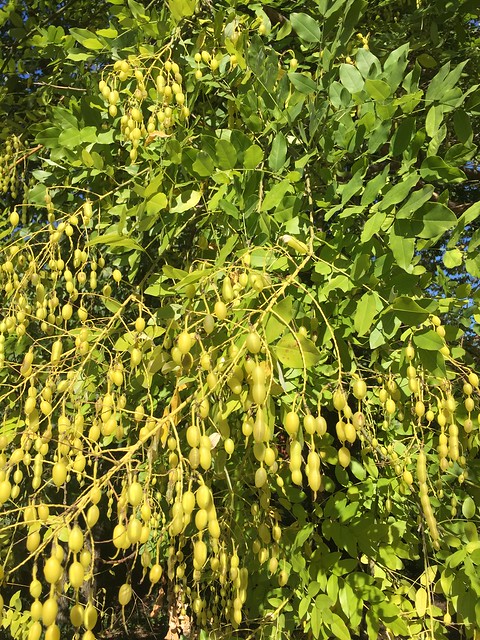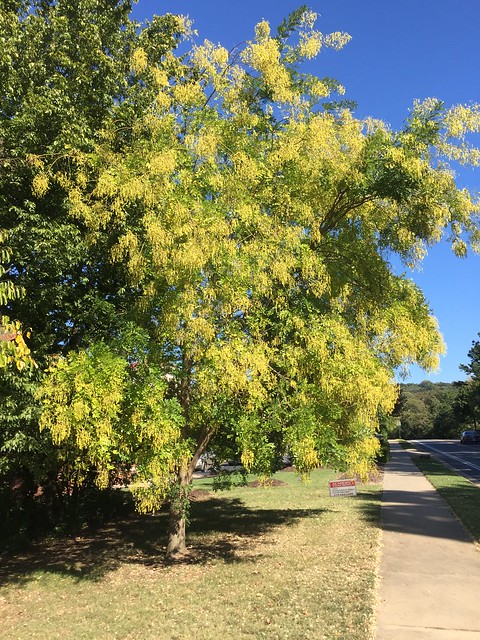Resource Library
Plant of the Week: Japanese Pagoda Tree, Chinese Scholar tree

The pods of scholar tree appear in the fall as dangling strands of beads. (Image courtesy Gerald Klingaman)
FAYETTEVILLE, Ark. – After many trips down a particular street here in Fayetteville, a tree I’d never noticed before jumped out at me last fall. It was growing in front of a private school, and appropriately enough, was a Chinese Scholar Tree (Styphnolobium japonicum).
Chinese Scholar Tree, also called Japanese Pagoda Tree, is one of four species of leguminous trees in this genus and the only one that is cultivated. For over two centuries this tree was given the name Sophora japonica, but the four species were removed from that genus because they lacked the ability to fix nitrogen as do other species of Sophora. The generic name translates from Greek as “sour pod.
Scholar tree is a deciduous, round-headed tree growing to 50 feet or taller with a somewhat open, slouchy look while young. It has compound leaves with 7 to 17 two-inch-long leaflets. The leaves hold late in the season and usually show little in the way of fall color but, when frost is long delayed, may show some yellow hues.
White, slightly fragrant, pea-like flowers in broad panicles six to ten inches tall appear in July and into September. In more northern climates scholar trees are considered shy to flower, but in hotter regions flowering is better. In the fall, clusters of six to eight-inch-long waxy pods (legumes) are produced with six or more seeds forming lumps like a snake eating eggs.
The scholar tree was introduced into France in 1747 by Pierre d’Incarville (1706 – 1757), a French Jesuit priest who was allowed to poke around Peking (now Beijing) in the middle of the eighteenth century. The priest was allowed into the Old Summer Palace to advise the Emperor on the techniques of growing European flowers in the Emperor Yong’s “Garden of Perfect Brightness”.
D’Incarville introduced a number of Chinese trees, including mimosa, golden raintree and tree-of-heaven, by entrusting seeds to traders from Russia who showed up in the Chinese capitol once every three years. The camel caravan across Mongolia and much of Siberia took over a year. Eventually the seeds arrived in Paris, where they were successfully germinated. It was introduced to the United States in 1811.
According to one source, flowering of scholar trees during the eighth moon (September in the western calendar) was significant because that was the month exams for political patronage jobs in the courts were meted out. Perhaps because of this connection, the tree was also planting on the graves of scholars and in temples.

The native range of scholar tree is somewhat in doubt. It has been cultivated in China and Japan for centuries, but the Flora of China says unequivocally it is native to Japan and Korea. Most Japanese sources say it was introduced from China. The North Koreans, possibly its original homeland, don’t have anything to say on the topic.
Scholar tree is hardy from zone 4 through 7. It is best in a sunny site in good, loamy garden soil where it grows quickly once the roots are established. Trees have good heat and drought tolerance. Scholar trees are used as street trees, specimens where they might shade a patio or as a stand-alone specimen in the lawn. In the southern end of their range, the species may not be as long lived (30 to 40 years) as it is in colder regions, but it is still a worthy tree for the garden.
For more information about horticulture or to see other Plant of the Week columns, visit Extension’s Website, www.uaex.uada.edu, or contact your county extension agent. The Cooperative Extension Service is part of the U of A Division of Agriculture.
Pursuant to 7 CFR § 15.3, the University of Arkansas System Division of Agriculture offers all its Extension and Research programs and services (including employment) without regard to race, color, sex, national origin, religion, age, disability, marital or veteran status, genetic information, sexual preference, pregnancy or any other legally protected status, and is an equal opportunity institution.